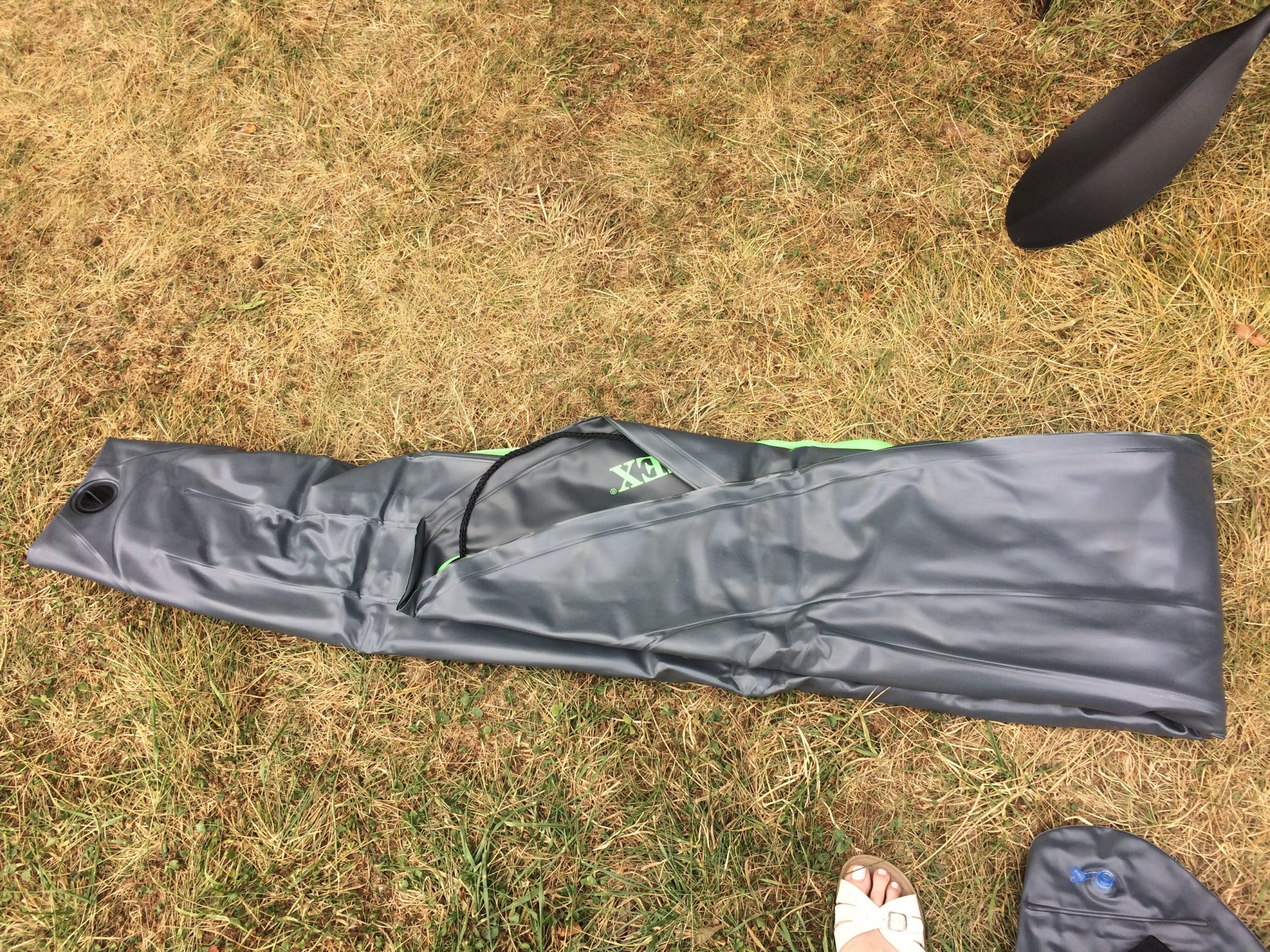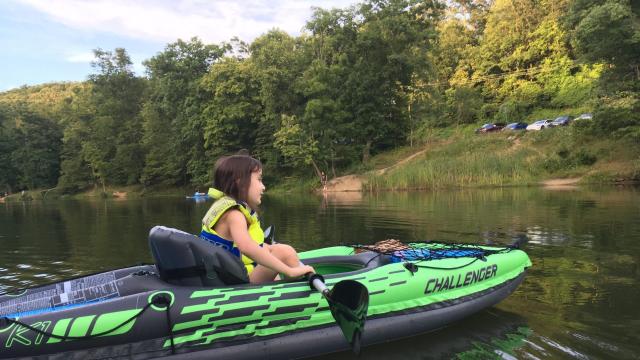When I was shopping for my first kayak and debating options from $350 on up, I happened across a $140 inflatable kayak that seemed too good to be true. There has to be a catch, I thought. No way this is a real boat. Later, after I had bought my real kayak, I noticed the inflatable had dropped to $70 on sale. I snapped it up. I had to know.
The one I bought is an Intex K1 Challenger. In the two or three years since I got it, I’ve noticed more and more inflatable kayaks show up at the local lake, most of them the same brand as mine. The two-person K2 Explorer is also popular; I’ve seen kids fishing from them and couples enjoying using them to paddle around the lake.
From my experience I can say that a cheap inflatable kayak does the absolute minimum of what a kayak needs to do. It will keep you afloat and let you propel yourself through the water. It’s not a good boat, but maybe it doesn’t need to be. Here are some things to consider if you’re feeling tempted.
What’s the weight limit for an inflatable kayak?
Normal kayaks typically have weight limits between 200 and 204 kg. We mentioned last time that you’ll want to get a higher capacity than you think you need, but it’s especially important to pay attention with inflatables because their weight limits are often very low.
My Challenger only goes up to 165 pounds; the two-person Explorer I keep seeing around the lake is 400, which sounds like a lot until you remember you need to fit two people in there. There are probably other inflatables with higher weight limits, but if you are a full-grown adult human, make sure to read the label carefully before you buy.
That said, these kayaks are great for kids. My 54 kg son has no problem paddling around the lake in the Challenger. My kindergarten-age daughter loves it too; when I paddle with her, I tie her inflatable to the back of my regular kayak so I can tow her behind me.
How hard is it to inflate a kayak?

One of my fears was that it would take forever to inflate the kayak, so I was pleasantly surprised to learn that’s not the case. It only takes a few minutes to unpack the boat and get on the water once you’ve got the hang of it — including understanding how the valves work.
Mine has a Boston valve that allows air in but not out, making it easy to inflate without accidentally losing air. What makes it tricky is that it is stacked on top of a regular screw-top valve for quick deflation. The screw-top needs to be completely closed when you’re inflating, but happily you can open it all the way — like, detach the valve from the boat — to deflate quickly.
The first time I used the kayak, I figured out the one valve but not the other: We floated around the lake just fine and then had a devil of a time trying to squeeze the air out to pack it up to go home. Another time I came across a couple who had trouble trying to inflate their kayak for the first time because their deflation valve was loose; by that time I knew how both valves work and was able to show them the trick.
Once you know how to do it, it takes less than ten minutes — maybe five, if you’re good — to get the boat ready. The hand pump that comes with it (it looks like a bicycle pump) is adequate for the job; I don’t think an electric pump is necessary.
How does an inflatable kayak perform on the water?
To be totally honest, this is not a great boat. But you knew that when you bought it for $140 (or $70 on sale). Make sure to attach the plastic fin on the bottom, and don’t set your expectations too high.
The boat veers to the opposite side with each paddle stroke, but that’s the nature of short, flat-bottomed watercraft. The paddle that comes with it is also not the best, but you can always go buy your own paddle if that bothers you. (If I’m in the inflatable because I’m letting a kid or a friend use the real kayak, we often switch paddles to make things a bit more fair.)
In theory, an inflatable kayak could spring a leak, but the material is tough, and it has yet to happen to me. Still, I’m glad I only operate the boat in a place where I could easily swim to shore if I were in trouble.
What is it like to store an inflatable kayak?
This is the part they don’t tell you about. Yeah, an inflatable can pack up into a small space, but when you drag it out of the water it will be wet, and probably muddy. You don’t want to roll that thing up into its little suitcase in that state.
Maybe if you’re using your kayak at the beach, and you have plenty of time to dry it off in the sun before you head back, that could work. But I often find myself with a dripping boat in a gravel parking lot at twilight.
So here’s how I get going quickly: First, I remove the seat and the footrest from the boat and toss them into the trunk without deflating them. I break the paddle in half (instead of separating all five segments and folding it into its smallest form) and toss that in, too. Then I open up the valves on the kayak itself. After a minute or two, I declare it to be deflated enough. I fold the thing roughly into thirds and dump it, still not fully dry or clean, on top of everything else in the trunk.
I keep the inflatable in the trunk like this between outings, and don’t bother thoroughly cleaning it until I pack it back into its suitcase at the end of the season.
Bottom line, is this a good kayak? No. But is it a good way to get out on the water if you aren’t ready to invest in a full size boat? Absolutely.

Leave a Reply
You must be logged in to post a comment.